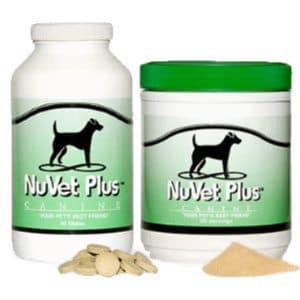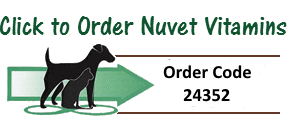Experiencing Dog Paw Pad Problems?
Dog Paw Pad Problems By Janice Jones |Last Updated 06-14-2022
I’ll admit, discussing our Tzu’s dog paw pad problems sounds a bit boring but when your favorite canine can’t stop biting, licking and otherwise trying to mutilate those lovely feet, finding help may be the first thing on your mind.
It certainly was for me when my daughter’s Tzu seemed miserable. His otherwise lovely coat looked a bit too red in its extremities and by red, I meant the irritated skin and the red hair that was presumably due to some type of yeast infection. I wanted to help but wasn’t sure where to start. This article is the result of my search for solutions.
Dog Paws are remarkable structures that allow dogs to walk surfaces that you or I might find challenging from super cold surfaces, slippery ice, rough terrain and even rocky slopes. A dog’s paws are the only part of his body that contain sweat glands that produce perspiration, helping to keep the dog cool on hot surfaces and keeping the pads moist so they don’t become dry and cracked. The fatty tissue that make up their paw pad do not freeze as normal skin does giving the dog an advantage on cold, frozen ground.
Paws can also communicate emotions because just like humans who get sweaty hands when nervous, dogs get sweaty paws under stress. The scents given off by paws can mark territory. So, if you have ever witnessed your dog sniffing the ground, he just might be searching for those sweaty paws that came before him.
Types of Dog Paws
Dog Paws are not all created equally. They vary in size, shape and structure.
Hare Feet: Some dogs have what is called Hare paws, slender paws with the two middle digits longer than the outer ones. This type of foot is created for speed and quick movements like the feet of rabbits. Breeds with this type of paw structure are medium size to larger breeds known for their ability to run fast. Think Greyhound and Whippet.
Cat Feet: Some breeds have rounded, compact paws that are perfect for giving these dogs greater endurance. You would find these on large and giant breed dogs. Experts call these “cat feet” They are designed to keep dogs stable, bear great weight and provide for endurance.
Webbed feet: As the name implies, dogs with this type of food are excellent swimmers and many excel at hunting on all types of terrains. Water dogs such as the Labrador Retriever will have this type of paw.
Hairy Paw Pads: Many breeds including the Shih Tzu have hair that continues to grow between the pads and must be removed periodically by a human.
Paw Pad Anatomy
If you are interested in anatomy, you’ll be glad to know there are only five main parts of a dog paw.
- Claws
- 4 Digital pads
- Metacarpal pad
- Dewclaw
- Carpal pad
- Claws
Claws or toenails: are used for digging, scratching, and gripping and are made up of the protein, keratin. The blood supply feeds the cuticle but the end of the claw is dead tissue. They grow rapidly so clipping the nails will help avoid injury.
Dewclaws: Many dogs have a fifth nail on the front paws and some have them on the back as well. Dewclaws are considered to be a vestigial structure and that is why some people advocate removing them before the puppy turns five days old.
Four Digital Pads: These are made up of thick subcutaneous fat tissue that help absorb shock for the bones and joints that make up the dog’s feet and legs. They also act as a protective cushion and the structure which bears the most weigh when the dog walks. The digital pads and metacarpal pads serve similar purposes.
Metacarpal/Metatarsal pad: The largest pad is located next to the four digital pads and provides shock absorption and traction as the dog walks or runs. The thicker the pad, the better it is a shock absorption. Just as in humans, the metacarpal refers to the front (or hands in humans) and the metatarsal is the hind (our feet and toes)
Carpal Pad: The carpal pad is located higher up on the pad and helps the dog maintain balance on steep surfaces or a slippery sloop.
Dog Paw Pad Problems
Seeing the amount of work that the dog paw does, it is no wonder it is subject to problems. They require regular maintenance and care.
Regular washing, massaging and hair removal will prevent a whole host of dog paw pad problems including the accumulation of sweat, bacteria and yeast that often produce that characteristic “Frito food” smell.
Regular attention also prevents mats from lodging between the pads on long breed dogs. Regular care will also prevent painful cracked paw pads, cuts, burns or abrasions due to chemicals and broken glass and the irritation that is caused by allergies.
While hard to prevent, your dog’s paws can also be subjected to growths, warts, corns or tumors. These growths are best left to the skillful hands of your veterinarian.
Common Dog Paw Pad Problems
Infections are the most common dog paw pad problems according to PetMD including fungal and bacterial. Ingrown or torn toenails are another source of problems as is burns, frostbite, and winter salt. Your Shih Tzu’s paw pads can also be a good breeding ground for ticks and mites and for most of us, too much hair is likely to be the cause of many of the fungal and bacterial infections.
In addition to these dog paw pad problems, your dog’s paws can get cracked or subjected to other problems including, Nasodigital Hyperkaratosis, Pemphigus, and Zinc Deficiency.
In many Shih Tzu dogs, allergies are the cause of their dog paw pad problems and the constant scratching and biting result in secondary infections. If you are just worried about their paw pads in the winter time, a soothing paw balm may be just what you need.
Solutions to Dog Paw Pad Problems
There is so much that we can and should be doing to keep our dog’s paws safe and clean and to prevent damage and illness.
- Clipping Nails
- Removing Hair from Paw Pads
- Keeping paw pads clean
- Inspecting Paw Pads for Injuries and issues
Cleaning our Dog’s Paws regularly
Beyond clipping your dog’s nails, the next best thing you can do to help your dog maintain good paw health is to clean those little feet regularly.
Not only will cleaning their paws help them prevent disease, it will also keep your environment cleaner and safer for you and your family.
For some breeds such as Shih Tzu, removing the hair between the pads is the first step. If you take your Shih Tzu to the groomers, they will clip this hair for you. If you groom at home, you will need to remove this hair on a regular basis. How often?
Take a look at your Tzu’s paw pads. Can you see them or are they covered with hair? If you can’t see the pads, it’s time to trim either with a clipper or small round tip scissor.
Finally, it's time to explore some of the types of pad paw cleaners on the market.
How to Choose the Best Dog Paw Pad Cleaner
The second step is to clean the pads regularly with a high-quality paw cleaner.
Why not just soap and water, you might be asking.
When you bathe your dog, with a good quality shampoo, you are cleaning and massaging his paw pads, inspecting for growths and injuries, and assuring that there is no dirt, bacteria or yeast growth. This is important, but unless you are bathing weekly or more frequently, you are likely to miss some of the early signs of infection. That is where a good paw cleaner comes into play.
Types of Paw Pad Cleaners
Too many choices, makes choosing tough, but it doesn’t have to be. Of course, you can always go back to shampoo and bathe your dog’s paws every day, but who has time for that? Commercially, you might consider a dog paw wipe, a container that you fill with a cleaning solution that is just big enough to place a dog’s paw, or a simple paw spray.
Dog wipes work similarly to other wet wipes, simply wipe the paw and discard the wipe. Some are scented and others fragrance free and some have antibacterial or anti fungal properties. This is a satisfactory way of removing surface dirt such as when your dog comes inside after a walk.
Paw washing cups often contain silicon bristles that remove dirt and debris. You add a cleaning solution of your choice and remove the dog’s paw and dry. This is a deeper way to clean if your dog will allow having each paw immersed into a cup, but the process can take time. Many dogs coming inside are tired and thirsty and don’t want to be bothered.
Spray Cleaners work similar to dry shampoo solutions. They vary in the type of ingredients and their effectiveness.
My Recommendations
At Miracle Shih Tzu we always have plenty of little dirty paws and when you add in the number of puppies on the ground, keeping them clean is next to impossible. I’ve tried wipes but they don’t always work as well as I would like and often dry out before I use the entire package. The paw cleaning cups sound interesting but I think I could accomplish the same clean with a small coffee cup and soft brush. That is when I discovered the sprays.
I’ve used dry foaming shampoos for a long time, especially on puppies who seem to get dirty every day. It didn’t occur to me to find a paw spray that worked similarly until I used King Kanine Klean Paws™.
What is King Kanine Klean Paws™?
This product is a new, patented non toxic foaming paw cleaner that is formulated to kill 99.99% of all bacteria and germs that dogs carry on their paws every day.
Klean Paws™ is a cleaner that softens paws as it kills ringworm & roundworm (post-larval state). Additionally, it can prevent the passing of these potentially harmful parasites and other toxic bacteria to you, your family, and other pets. It comes in a handy travel size that fits easily in a backpack or pouch and can be used on the trail or after a walk.
What are the Active Ingredients ?
Benzalkonium Chloride (BAC), Triethylene Glycol
What is Benzalkonium Cloride?
This long sounding chemical is an antimicrobial and a preservative, and secondarily used as a surfactant. It works by killing microorganisms and inhibiting their future growth. You will find it used in a wide range of human applications including eye, ear and nasal pharmaceuticals, personal care products such as hand sanitizes, shampoos and deodorants, and skin antiseptics such as Bactine™.
You might even find it in throat lozenges and mouthwashes. Historically, Benzalkonium Cloride was used in eye care solutions, but has since been found to be potentially toxic to ocular structures, so this paw cleaner should not get in yours or your dog’s eyes.
What is Triethylene Glycol?
Triethylene glycol is a mild disinfectant effective against a variety of different types of bacteria. It is often found in cosmetics and other personal care products.
How to Use?
As with any foam cleaner, you spray it on and massage into the paw pads and surround foot area. Allow to saturate the area. If there is visible dirt or debris, you can wipe clean with a soft cloth, wash cloth or paper towel.
If you need to assure your dog's paws are totally dry, use a handheld drier with a pin brush.
Three Step Process
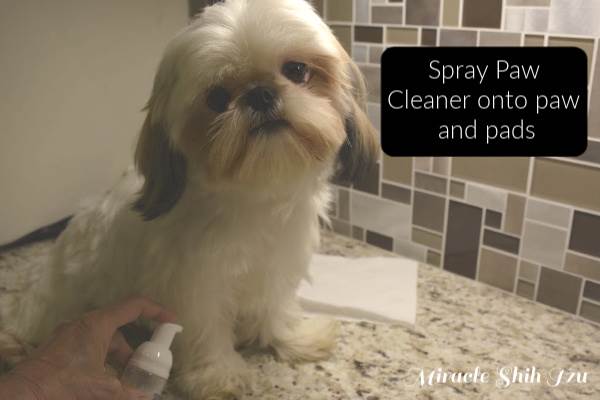 Spray paw cleaner onto paws an pads
Spray paw cleaner onto paws an pads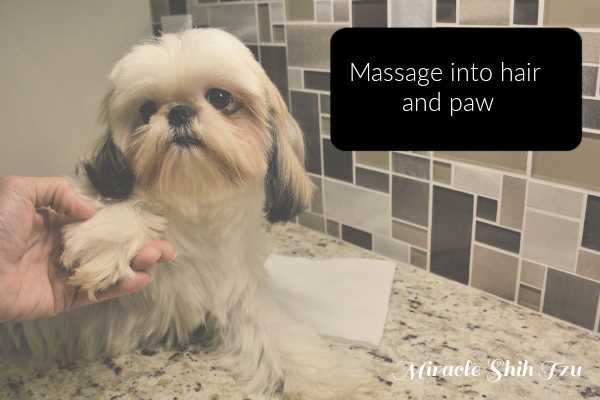 Massage cleaner onto paw pads and surrounding hair
Massage cleaner onto paw pads and surrounding hair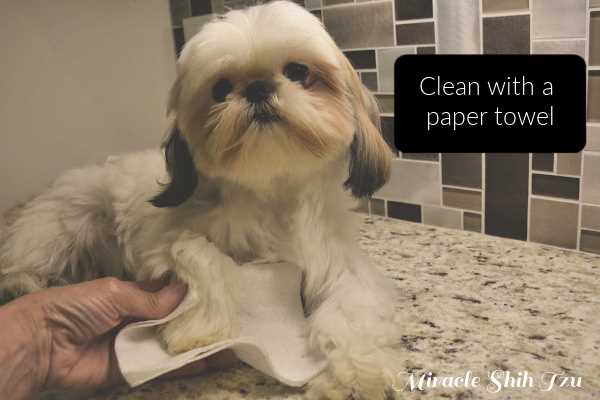 Wipe dry with a paper towel
Wipe dry with a paper towelProfessional Solutions to Dog Paw Pad Problems
We can go a long way towards keeping our Tzu’s paw pads clean, clipping nails, and removing hair, but some problems will require professional attention.
If cleaning regularly which means keeping the hair trimmed, bathing and using a quality paw pad cleaner between baths does not solve the problem, it is time to get medical attention.
Your dog may need allergy medicine, or
additional help for underlying problems such as autoimmune, liver, or zinc
deficiency that may be causing problems. If mites are the problem, your veterinarian will recommend products to kill the mites. If you notice a dog tick embedded between your dog's paw pads, you will want to remove it safely or seek vet care.
This article was for informational purposes only and not to be a substitute for professional advice.
Sponsored Post
"Hi, I'm Janice Jones, a former veterinary technician and Shih Tzu expert with over 40 years of experience with the breed. Through Miracle Shih Tzu, I combine my medical background and extensive breed knowledge to provide reliable, practical advice for Shih Tzu owners. My mission is to help you give your Shih Tzu the happiest, healthiest life possible through evidence-based information and real-world solutions. Whether you're new to the breed or a seasoned owner, you'll find trusted guidance here for all aspects of Shih Tzu care.
I hold an undergraduate degree in Psychology with a minor in biology, Early Childhood Education, and Nursing, and a Master's in Mental Health Counseling.
